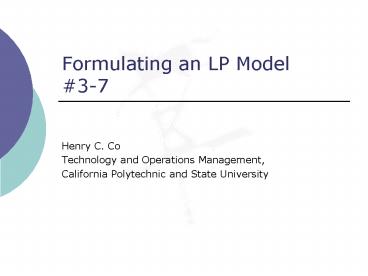Formulating an LP Model PowerPoint PPT Presentation
1 / 17
Title: Formulating an LP Model
1
Formulating an LP Model 3-7
- Henry C. Co
- Technology and Operations Management,
- California Polytechnic and State University
2
Basic Elements of a Linear Program
- Decision variables are the things over which you
have control, e.g. how much of a given product to
produce, how much to ship from a given plant to a
given market, etc. - An objective function (the payoff) is a
mathematical statement of what you want to
accomplish, usually maximizing profit, or
minimizing costs. - Constraints are mathematical statements of the
scarce resources of requirements that need to be
met that might limit the amount of profit you can
earn or force you to incur some cost.
3
Decision Variables
- Perhaps the most difficult task in formulating an
LP model is defining the decision variables. - For the blending problem, we have three choices
- to look at the output (finished goods),
- to look at the input (raw materials),
- or both!
- Choosing the wrong set of decision variables
often lead to difficulties in formulating the LP.
4
Oftentimes, the constraints provide valuable
clues to defining the decision variables.
5
- There are restrictions on the each output can
contained of each input. - Input A in Spicy sauce must be at least 25
- Input B in Spicy sauce must be at least 50
- Input A in Mild sauce must be at most 25
- Input B in Mild sauce is unrestricted.
- This suggests that there are 4 decision
variables - AS Input A in Spicy sauce
- BS Input B in Spicy sauce
- AM Input A in Mild sauce
- BM Input B in Mild sauce
6
- From the input, we know the output.
- Assuming 100 yield (or to be adjusted if less
than 100) - Total Spicy sauce produced Input A in Spicy
sauce Input B in Spicy sauce AS BS - Total Mild sauce produced Input A in Mild sauce
Input B in Mild sauce AM BM
7
Objective Function Net Revenue Sales Costs
- Sales 3.35 total Spicy sauce produced
2.85 total Mild sauce produced 3.35 (AS
BS) 2.85 (AM BM) - Costs 1.60 total input A used 2.59
total input B used 1.60 (AS AM) 2.59 (BS
BM) - Net Revenue
- 3.35 (AS BS) 2.85 (AM BM) - 1.60 (AS
AM) - 2.59 (BS BM) which simplifies to - 1.75 AS 1.25 AM 0.76 BS 0.26 BM
8
Constraint Set 1 ( of Inputs)
- of Input A in Spicy sauce
- AS / (AS BS) 25 which simplifies to
- -75 AS 25 BS 0.
- of Input B in Spicy sauce
- BS / (AS BS) 50 which simplifies to
- 50 AS - 50 BS 0.
- of Input A in Mild sauce
- AM / (AM BM) 75 which simplifies to
- 25 AM - 75 BM 0.
9
Constraint Set 2 (Available Inputs)
- Up to 40 quarts of A
- AS AM 40.
- Up to 30 quarts of B
- BS BM 30.
10
The Complete LP Model
11
- Maximize 1.75 AS 1.25 AM 0.76 BS 0.26 BM
- Subject to
- -75 AS 25 BS 0.
- 50 AS - 50 BS 0.
- 25 AM - 75 BM 0.
- AS AM 40.
- BS BM 30.
- Plus non-negativity restrictions.
12
Learning by Doing!
- Formulating an LP model can be tricky.
- The more you do, the easier it gets.
13
The Excel Worksheet
- Solving the problem is easy.
- Please refer to my PowerPoint notes on using
Solver.
14
Worksheet for Optimization
15
The Solver Parameters
16
The Optimal Solution
17
Summary

